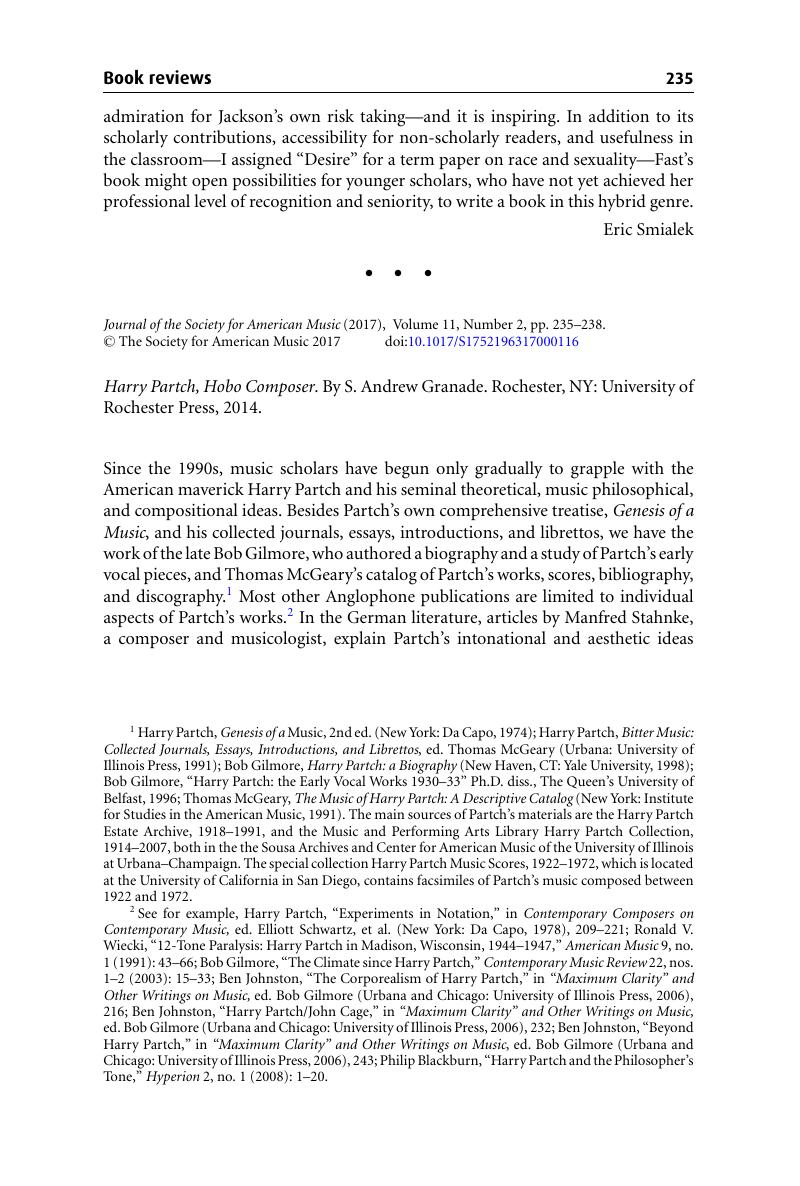No CrossRef data available.
Article contents
Harry Partch, Hobo Composer. By S. Andrew Granade . Rochester, NY: University of Rochester Press, 2014.
Published online by Cambridge University Press: 16 May 2017
Abstract

- Type
- Book Review
- Information
- Copyright
- Copyright © The Society for American Music 2017
References
1 Partch, Harry, Genesis of a Music, 2nd ed. (New York: Da Capo, 1974)Google Scholar; Partch, Harry, Bitter Music: Collected Journals, Essays, Introductions, and Librettos, ed. McGeary, Thomas (Urbana: University of Illinois Press, 1991)Google Scholar; Gilmore, Bob, Harry Partch: a Biography (New Haven, CT: Yale University, 1998)Google Scholar; Bob Gilmore, “Harry Partch: the Early Vocal Works 1930–33” Ph.D. diss., The Queen's University of Belfast, 1996; McGeary, Thomas, The Music of Harry Partch: A Descriptive Catalog (New York: Institute for Studies in the American Music, 1991)Google Scholar. The main sources of Partch's materials are the Harry Partch Estate Archive, 1918–1991, and the Music and Performing Arts Library Harry Partch Collection, 1914–2007, both in the the Sousa Archives and Center for American Music of the University of Illinois at Urbana–Champaign. The special collection Harry Partch Music Scores, 1922–1972, which is located at the University of California in San Diego, contains facsimiles of Partch's music composed between 1922 and 1972.
2 See for example, Partch, Harry, “Experiments in Notation,” in Contemporary Composers on Contemporary Music, ed. Schwartz, Elliott et al., (New York: Da Capo, 1978), 209–221 Google Scholar; Wiecki, Ronald V., “12-Tone Paralysis: Harry Partch in Madison, Wisconsin, 1944–1947,” American Music 9, no. 1 (1991): 43–66 CrossRefGoogle Scholar; Gilmore, Bob, “The Climate since Harry Partch,” Contemporary Music Review 22, nos. 1–2 (2003): 15–33 CrossRefGoogle Scholar; Johnston, Ben, “The Corporealism of Harry Partch,” in “Maximum Clarity” and Other Writings on Music, ed. Gilmore, Bob (Urbana and Chicago: University of Illinois Press, 2006), 216 Google Scholar; Johnston, Ben, “Harry Partch/John Cage,” in “Maximum Clarity” and Other Writings on Music, ed. Gilmore, Bob (Urbana and Chicago: University of Illinois Press, 2006), 232 Google Scholar; Johnston, Ben, “Beyond Harry Partch,” in “Maximum Clarity” and Other Writings on Music, ed. Gilmore, Bob (Urbana and Chicago: University of Illinois Press, 2006), 243 Google Scholar; Blackburn, Philip, “Harry Partch and the Philosopher's Tone,” Hyperion 2, no. 1 (2008): 1–20 Google Scholar.
3 See, for example, Stahnke, Manfred, “Gedanken zu Harry Partch,” Neuland: Ansätze zur Musik d. Gegenwart: Jahrbuch 2, ed. Henck, Herbert (Bergisch Gladbach: Neuland Musikverlag, 1982), 243–251 Google Scholar; Stahnke, Manfred, “Zwei Blumen der reinen Stimmung im 20. Jahrhundert: Harry Partch und Gerard Grisey,” Hamburger Jahrbuch für Musikwissenschaft 17, ed. Floros, Constantin, Geiger, Friedrich, and Schäfer, Thomas (Frankfurt/M.: Peter Lang, 2000), 369–88Google Scholar; Stahnke, Manfred, “Partch Harp: (Er)findung einer nicht-oktavierenden Musik,” in Musikkulturgeschichte: Festschrift für Constantin Floros zum 60. Geburtstag, ed. Peterson, Peter (Wiesbaden: Breitkopf & Härtel, 1990), 11–26 Google Scholar.
4 These five pieces constitute The Wayward, a collection of Partch's hobo music from 1935 to 1941.




